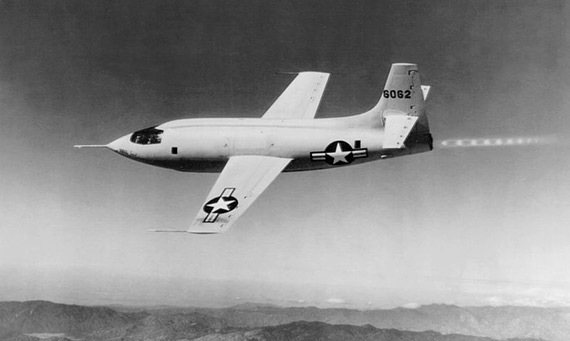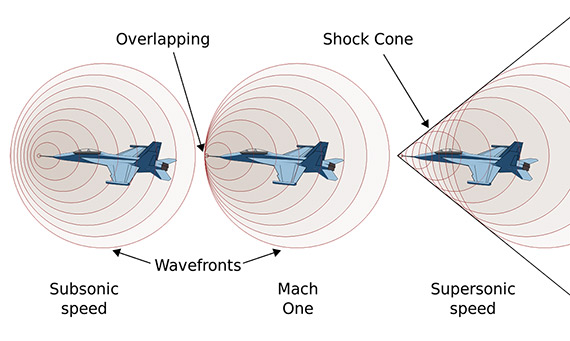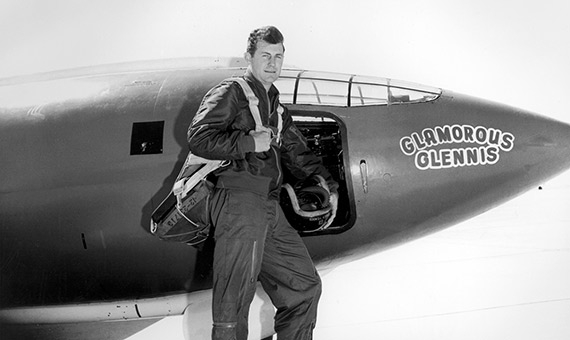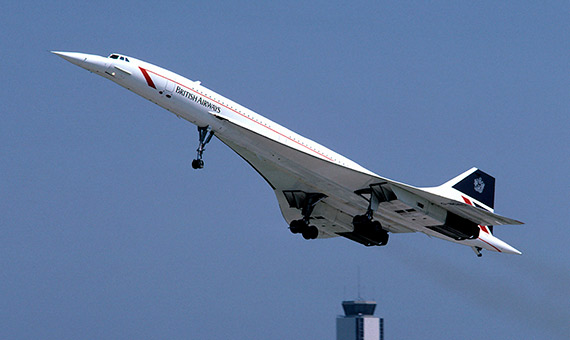Heavy thunder sounded in the sky above the Mojave Desert on October 14, 1947 when US Air Force captain General Chuck Yeager (February 13, 1923 – December 7, 2020) broke the speed of sound in an experimental flight that marked one of the milestones in the history of aviation. In 1935, the term “sound barrier” had been created, which seemed to imply a physical wall that could not be overcome, and it was then asked whether a man could “break” it. The United States Air Force achieved the feat 70 years ago and opened the door to scientific and technological discoveries.
On board the Bell X-1, and after three failed attempts, Yeager reached the speed of Mach 1—the speed of sound—equivalent to 1,225 km/h at sea level at a temperature of 15ºC. “It was a great pleasure to fulfil the task that old Colonel Al Boyd—considered the “Father of Modern Flight Testing” and the “Number One Test Pilot in the World”—had assigned me,” recalls Yeager, 94, in a conversation with OpenMind.

The design of the plane had a simple concept—if bullets could far exceed the speed of sound, the shape of the Bell X-1 had to be similar. The engine was a four-chambered rocket powered by liquid fuel, in a quantity to fly for just a few minutes. The solution was to hang the plane from the belly of a B-29 bomber that lifted it to the proper altitude. From there it was released and began the flight that would go down in history.

When an object travels through the air, it is surrounded by pressure spheres caused by the displacement it creates in the air with its movement. As it moves faster, it begins to reach those pressure spheres in one direction, causing them to compress in front of the aircraft and forming an air chamber denser than the one behind. When the craft is about to break the sound barrier, the air in front is compressed so much that the pressure spheres begin to be left behind. “Shock waves generate a pressure jump above and below the aircraft, causing the sonic boom, which is what you hear when the craft overcomes the barrier,” explains Miguel Angel Barcala, director of the Aircraft and Space Vehicles Department of the Higher Technical School of Aeronautics and Space of the Polytechnic University of Madrid.
An achievement that took us into space
And why was the first supersonic flight so important? General Yeager sums it up in one sentence: “Without that achievement, we would not have made it to space.”
The concept of supersonic movement had existed since the late nineteenth century thanks to Ernst Mach, an Austrian physicist who discovered the so-called “Mach cone” and that the relationship between the speed at which the body moves and the speed of sound is a very important physical factor—Mach’s number. Yeager proved that the human body could move at that speed. “That permitted the launching of the rockets that took us into space, for which it is necessary to reach the escape velocity of the Earth,” says Barcala.

The professor also points out the technological leap in aeronautical materials, which had to be adapted to withstand the high temperatures behind the shock waves when an aircraft makes a supersonic flight. “Another consequence was the development of reactors that can provide the thrust needed to fly at these speeds, as well as the study of fuels or additives that optimize the operation of supersonic aircraft, reducing consumption, lowering pollution and providing greater thrust,” he adds.
Commercial supersonic flights
After that first flight, the technological optimism of the 1950s led to the belief that supersonic flights were the future of commercial aviation, even though it was now known to be difficult—supersonic aircraft need more powerful engines and consume more fuel. Only two projects prospered, the Anglo-French Concorde and the Soviet Tupolev Tu-144. The latter did not complete a year of commercial life, while the 14 Concorde commercial aircraft, with their velocity of Mach 2 (twice the speed of sound) flew for 27 years.
“It was not a technological failure, but an economic failure,” says Barcala. The Concorde consumed more than 25,000 litres of kerosene per hour and carried up to 100 passengers, while some Boeing planes required about 15,000 litres per hour and could carry more than 500 people. In addition, the restrictions against supersonic pollution—that annoying sonic boom—limited the areas in which the aircraft could fly.

Institutions such as NASA—which has successfully conducted tests to reduce the volume of the sonic explosion and now investigates how to get “practical supersonic vehicles”—as well as private companies, are working on ways to revitalise such flights. The start-up Boom aims to build faster and cheaper planes than the Concorde that fly at Mach 2.2 speed (2.6 times faster than current airlines). This would allow traveling from London to New York in three and a half hours.
Barcala says there are projects that want to go further and combine supersonic and stratospheric flights. “The displacements would be faster, less expensive and polluting, but only effective over long distances, never on local or continental flights,” he says.
Comments on this publication